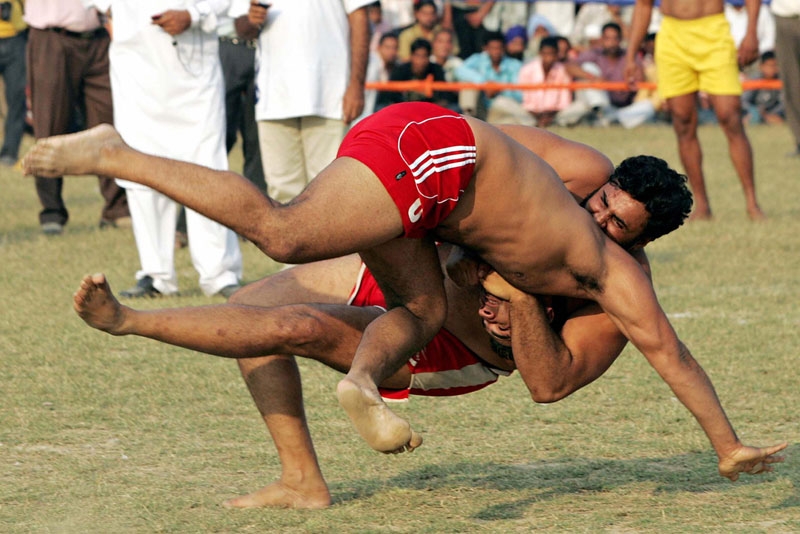Ready Go
Kabaddi Rules
Kabaddi is a popular contact sport in Southern Asia that first originated in Ancient India. It is played across the country and is the official game in the states of Punjab, Tamil Nadu, Bihar, Telangana and Maharashtra. Outside of India it is a popular activity in Iran, is the national game of Bangladesh and is also one of the national sports of Nepal where it is taught in all state schools. Kabaddi is also popular in other parts of the world where there are Indian and Pakistani communities such as in the United Kingdom where the sport is governed by the England Kabaddi Federation UK.

There are many regional variations of the game of Kabaddi in India, including Sanjeevani, Gaminee, Punjabi and Amar versions, all of which have slightly different interpretations of the game and its rules. There are also other games very similar to Kabaddi in both India and other countries that may not be pure Kabaddi, they are very closely related. These include the game of Hadudu that is played in Bangladesh, the Maldives’ Baibalaa and Maharashtra’s Hututu.
Object of the Game
The overall object of the game is to simply score more points than the opposition team within the allotted time. To do this, each team must attempt to score points by both attacking and defending. When attacking, the offensive team sends across a raider into the opposition’s half who must touch one of more members of the opposition to score a point. When defending, the objective is to capture the raider by wrestling them to the ground or simply by preventing them returning to their own half by the time their breath is up.
Players & Equipment
Kabaddi is played by two teams that both consist of twelve players each. However, only seven players per team are allowed on the field of play at any one time. The Kabaddi playing surface measures 13m x 10m and is separated into two halves by a white line, one team occupying each half. It can be played on a wide range of surfaces from a dedicated clay court to spare ground where a playing surface has been chalked out.
Unlike so many other popular sports and games, Kabaddi is a game that genuinely needs no special equipment, clothing or accessories, ensuring it is a game that is open to everyone.
Scoring
Scoring in Kabaddi is relatively simple. Teams score one point for each opponent that they put out of the game. Putting an opponent out (and thus scoring a point) is done in different ways. When attacking, this is done by the raider touching opposition members, putting them out. When defending, it is done by preventing the raider returning to their own half.
Bonus points are also available in Kabaddi. The raider can earn an extra point by successfully touching the bonus line in the opposition’s half. Three bonus points are available to a team when all of their opponents are declared out and a point is also available if any part of an opposing team member’s body goes outside of the boundary.
Winning the Game
At the end of the match, the team with the most points is declared the winner. If at the end of the game both teams have the same amount of points, then the game is deemed to be a draw.

Rules of Kabaddi
- Each team shall consist of no more than 12 players with only 7 taking to the field at any one time.
- Because of the physical nature of Kabaddi, matches are categorized in age and weight categories.
- There are six officials looking after each Kabaddi match. The officials comprise of a referee, a scorer, two assistant scorers and two umpires.
- The duration of the match is two halves of 20 minutes with a half time break of 5 minutes.
- At the start of a Kabaddi match, there is a coin toss with the winner having the choice as to whether to have the first raid or not. In the second half of the match, the team that did not raid first shall begin the second half with a raid.
- To win a point when raiding, the raider must take a breath and run into the opposition’s half and tag one or more members of the opposing team and then return to their own half of the pitch before inhaling again.
- To prove that another breath hasn’t been taken, the rider must continue to repeatedly yell the word ‘Kabaddi’. Failure to do this, even for just a moment means that the rider must return to their own side of the court without points and the opposite team is awarded a point for a successful defense play.
- The team being raided is defending, and the players must prevent the raiders from tagging them and returning back over the halfway line. Whilst in defence, a team may score a point by successfully preventing the raider returning to their own half after tagging them. Raiders may only be grabbed by their limbs or torso, not by their hair, clothes or anywhere else, and defenders are not permitted to cross the centre line.
- Each team will take turns in raiding and defending. Following halftime, the two teams switch sides of the court and the team who defended first in the first half begin the second half by raiding.
- The game continues in this way until the time is up, the team with the most points at the end of the match is declared the winner.
